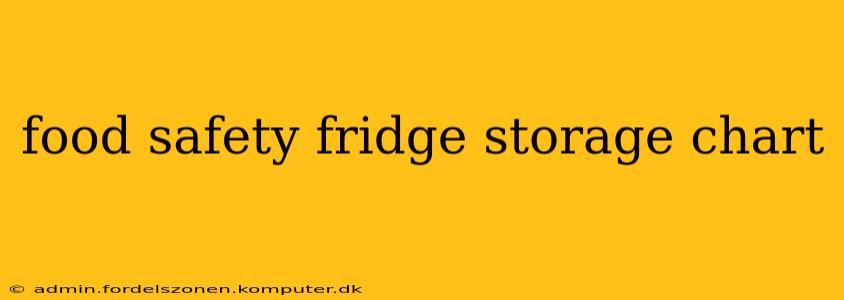Keeping your food fresh and safe requires more than just shoving it in the fridge. Understanding proper food storage is crucial to preventing foodborne illnesses and reducing food waste. This comprehensive guide provides a detailed food safety fridge storage chart and answers common questions about maximizing the lifespan and safety of your refrigerator's contents.
What is a Food Safety Fridge Storage Chart?
A food safety fridge storage chart is a visual guide that outlines the ideal storage location and duration for various food items in your refrigerator. It helps you organize your fridge efficiently, ensuring that the most perishable items are stored in the optimal temperature zones. Proper storage not only extends the shelf life of your food but also minimizes the risk of bacterial growth and food poisoning.
Understanding Refrigerator Temperature Zones
Before we delve into the chart, it's important to understand the temperature variations within your refrigerator. Generally:
- The coldest area: This is typically the back of the refrigerator, on the shelves, or in the crisper drawers. This is where you should store highly perishable items.
- Mid-range areas: The shelves in the main compartment are suitable for most foods.
- Door: The warmest area of your refrigerator, best suited for items that are more stable, such as condiments and beverages.
Food Safety Fridge Storage Chart
The following chart provides general guidelines. Always check individual food packaging for specific storage instructions.
| Food Item | Storage Location | Maximum Storage Time | Notes |
|---|---|---|---|
| Dairy | Coldest Area | Varies (Check labels) | Milk, yogurt, cheese – ensure airtight containers to prevent cross-contamination |
| Meat (Raw) | Coldest Area | 1-2 days | Wrap tightly to prevent leakage and bacterial growth. |
| Poultry (Raw) | Coldest Area | 1-2 days | Wrap tightly; avoid cross-contamination with other foods. |
| Seafood (Raw) | Coldest Area | 1-2 days | Wrap tightly; use within 24 hours for optimal freshness. |
| Leftovers | Coldest Area | 3-4 days | Store in shallow, airtight containers to promote faster cooling. |
| Cooked Vegetables | Coldest Area | 3-4 days | Store in airtight containers. |
| Fruits (Fresh) | Crisper Drawer | Varies (Check labels) | Wash before storing. Store some fruits separately to prevent ethylene gas damage. |
| Vegetables (Fresh) | Crisper Drawer | Varies (Check labels) | Wash before storing; store leafy greens loosely wrapped. |
| Eggs | Door or Shelf | 3-5 weeks | Store in the carton; avoid storing eggs in the door. |
| Condiments | Door | Varies (Check labels) | Store in airtight containers. |
| Beverages | Door | Varies (Check labels) |
H2: How long can I safely keep leftovers in the fridge?
Leftovers should ideally be refrigerated within two hours of cooking. Once refrigerated, they are generally safe to eat for 3-4 days. However, always check for any signs of spoilage, such as an off odor, slimy texture, or unusual color changes. If in doubt, throw it out.
H2: What is the best way to store raw meat in the refrigerator?
Raw meat should always be stored in airtight containers or tightly wrapped in plastic wrap or aluminum foil on the coldest shelf of your refrigerator, ideally at the back. This prevents juices from leaking and contaminating other foods. Make sure raw meat is placed on a lower shelf to avoid any dripping onto other food items.
H2: How can I tell if food has gone bad?
Several indicators signal spoiled food. Look for changes in:
- Smell: An unusual or sour odor is a clear sign of spoilage.
- Appearance: Mold growth, discoloration, slimy texture, or unusual changes in consistency are warning signs.
- Taste: If it tastes off, don't risk it!
H2: What is the best temperature to set my refrigerator?
The ideal refrigerator temperature is between 35°F and 38°F (1.7°C and 3.3°C). You can use a refrigerator thermometer to ensure your fridge is maintaining the correct temperature.
Conclusion:
Maintaining proper food safety through correct refrigerator storage is paramount for preventing foodborne illnesses. By following the guidelines in this food safety fridge storage chart and practicing good food handling techniques, you can ensure your family's health and minimize food waste. Remember to always check food labels for specific storage instructions, and when in doubt, throw it out.
